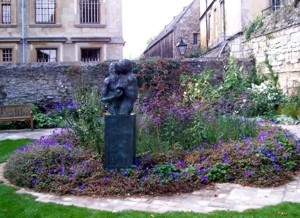 This
sculpture is one of a very few which I originally produced
purely for myself, and its symbolism has personal significance.
This
sculpture is one of a very few which I originally produced
purely for myself, and its symbolism has personal significance.
The Creation of Adam & Eve
Height 78"
Edition:
9
 This
sculpture is one of a very few which I originally produced
purely for myself, and its symbolism has personal significance.
This
sculpture is one of a very few which I originally produced
purely for myself, and its symbolism has personal significance.
Variations
on the image of Adam's creation have been represented countless times
over the centuries, important to artists as a symbol of the creative
act. The biblical story of Creation represents, for me, a God who has an
idea, a concept, but until the point where he makes a man in the
physical world, that man is not a reality. Once man is actually created,
he takes on an existence outside his creator. Only then can God
communicate with him, because it is only then that he has a life (if
disobedient) of his own. The story is a paradigm for every act of
creation, whether of a child or a work of art. The act of creation
liberates the created from the creator. Conception is not yet life and conceptual
art is therefore, in my view, a contradiction in terms.
In
this sculpture Adam and Eve are not yet fully formed; the claywork is
unfinished and Adamís spine has not been totally covered with flesh. The
only complete image above the plinth is that of the apple, placed in the
garden before the couple were made, a symbol of freedom and the
responsibility that goes with it.
The plinth bears on its front face a semi-abstract image which I originally produced as a painting. It is both a representation of the generations of Adam, and a kind of Dance of Death. Two lovers dance across a grid of squares and oblongs which represent the grave, while three embryos spread out from the position of the womb like ripples, the final one breaking the ultimate grave image, the block itself. The design is then broken into its constituent parts on the three remaining faces of the plinth in order to give an insight into its structure.
 As
I worked on this piece, several literary allusions came to mind and
influenced its development. I was conscious of Milton's portrayal of
Adam's loyalty and love after Eve's act of disobedience; of Hopkins The Wreck of the Deutchland,
particularly the lines:
As
I worked on this piece, several literary allusions came to mind and
influenced its development. I was conscious of Milton's portrayal of
Adam's loyalty and love after Eve's act of disobedience; of Hopkins The Wreck of the Deutchland,
particularly the lines: